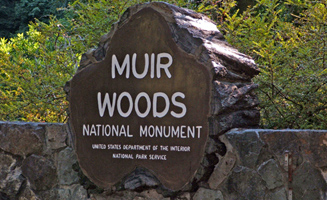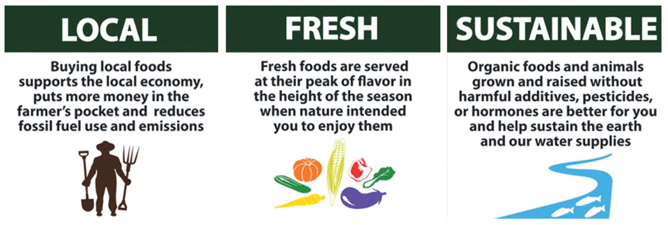Thanks to a complete overhaul of the food and gift concession program at Muir Woods National Monument by park management, working in partnership with the Institute at the Golden Gate (IGG), Muir Woods now offers to its guests the healthiest and most sustainable food in the entire national park system.

Management at Muir Woods National Monument overhauled the park’s food concession program to promote local, organic and sustainable food. The park’s new menu, which was rolled out in the Fall of 2009, has increased food sales at the park by $300,000 over the last year and is the healthiest in the entire National Park Service system. Photos courtesy of the National Park Service
By Bill Picture
Published: December, 2010
|
|
On the menu at the Muir Woods Trading Co., as the property’s cafe was renamed, 90 percent of the dishes are what park management defines as “healthy.” Of the ingredients that go into those dishes, Roth says that 70 percent are local, meaning they travel no more than 80 miles from their source to the park. Additionally, 95 percent of the produce and meats are from local farms; and 75 percent are certified organic.
On November 7, Golden Gate National Recreation Area Deputy Acting Superintendent Aaron Roth spoke to a crowd at IGG’s headquarters in Sausalito’s Fort Baker and discussed plans to take the aptly named “Food for the Parks” program to other NPS properties. Roth was joined by representatives of the Marin Agricultural Land Trust, leading environmentalist Bill McKibben, and food activist Larry Bain. Together, the panel outlined for the audience the many documented benefits of offering healthy and sustainable food choices to visitors of the national parks.
Measuring success
Roth reported that food sales at Muir Woods in the one-year period since the introduction of the new menu were $300,000 higher than for the previous year. But food activists insist this amount is far outweighed by the health, ecological and sociological benefits afforded by such a program.
“I don’t think anyone would argue anymore with the fact that a tomato from a farm 50 miles away is better for the environment than a tomato from a farm 500 or 1,000 miles away, not to mention it tastes better,” said McKibben, a frequent contributor on the environment to publications including the New York Times and Mother Jones, as well as the founder of the environmental action group 350.org.
Enough Americans now realize the value of buying local that farmers markets have become the fastest growing segment of the food industry in this country. And that growing demand for fresh-from-the-farm food has many Americans returning to this country’s agricultural roots. Two years ago, the USDA reported that, for the first time in 150 years, the number of small farms had actually increased.
But McKibben considers buying local to be more than just a sound green choice. He also considers it a learning opportunity: “Sure, we learn about our food, where it grows, how it grows, who grows it. But we also learn about community, and our neighbors.”
“You know, someone followed shoppers around at a farmers market and found that they had ten times more conversations per visit than people who shop at supermarkets,” he continued. “You might say that, in addition to providing us with a deeper connection to the people and places providing what we eat, the farmers market has reintroduced us to each other. That’s invaluable.”
“Now the question is, ‘How do we take this program to a broader audience?’” said Roth.
Roth was a driving force behind the changes at Muir Woods. Under his direction, the park’s food concession contract was put up for bid and a point system established to encourage bidders to integrate sustainability into every aspect of operation. “Basically, we issued a call-to-action to food providers,” Roth explained. “Sustainable food and healthy food became our top priorities; and that encouraged providers to be more creative.”
For the Food for the Parks initiative, IGG, a collaboration between the National Park Service (NPS) and the Golden Gate National Parks Conservancy, intends to build on Muir Woods’ success, providing to parks elsewhere in the country the support necessary to adopt and implement similar sustainable food policies. Participation would be voluntary at this point, as the mandate from agency heads in Washington, D.C., is at best a long-term goal.
While the event’s panelists applauded the success of the Muir Woods program, they insisted that replicating it will not be easy. For the Food for the Parks program to work at other parks, they said it will have to be retooled to suit each region. “What works here in Marin won’t play well in other parts of the country,” said politician-turned-chef Bain, co-creator of Let’s Be Frank, one of the first sustainably produced hot dogs.
Bay Area advantage
According to Bain and his fellow panelists, there are two reasons why replicating the Food for the Parks program will be not be a simple cut-and-paste operation. One is that Bay Area food providers have easier access to sustainable food than providers in other parts of the country, with dozens of working farms and ranches within a stone’s throw of the Bay.
Most of those farms and ranches employ sustainable methods that shadow the NPS’ interest in sustainability and conservation. That’s thanks in part to the efforts of groups like the Marin Agricultural Land Trust (MALT). The organization, which is made up of farmers and ranchers working hand-in-hand with environmentalists, has fought to permanently preserve land in Marin County for agricultural use that would surely otherwise fall prey to commercial development.
Through the acquisition of conservation easements, MALT has protected more than 41,800 acres and helped ensure the survival of 66 family farms and ranches.
For other parks in the NPS system, the definition of “local” might need to be expanded; and “sustainable” might have to be followed by “when possible.” For instance, Grand Canyon National Park’s nearest farm might be hundreds of miles away, as the desert surrounding the park is too arid for many crops. In that case, “local” would need to be redefined as “closest.”
For parks bordered by agriculturally viable land, IGG would like to see more effort made to promote and protect local farming and ranching. With the help of an open-space-minded organization like MALT, other parks could strike a balance similar to the mutually beneficial one that Muir Woods National Monument has struck with IGG, its food provider, MALT and local farmers and ranchers.
The simple issue of availability means that each park’s menu will feature ingredients that others do not. For instance, artichokes and strawberries will likely never make an appearance at parks in the south, as they are largely western crops and therefore would have to be trucked long distances.
But, rather than looking at this as a challenge, McKibben suggests looking at it as an opportunity to showcase regional delicacies. “We’re actually being deprived of choices because homogenous has become the norm,” he said. “No matter where you go in this country or what time of year it is, you can find a strawberry at the supermarket. There’s something wrong with that. Moving away from generic is the best thing that could happen to this country, because there’s a world of amazing tastes that we’re missing out on. This is an opportunity to introduce or reintroduce those tastes into our mental vocabulary.”
Tofu or not tofu…
The second challenge will be adapting concession menus to suit the specific tastes of each park’s visitors. Once again, McKibben suggests challenging palates. But Bain recommends modest-to-medium changes to avoid altogether alienating less adventurous eaters.
“The revolution has to be a delicious one,” Bain joked. Still, both agreed that a national park is the perfect place to help broaden picky eaters’ culinary horizons.
“When you come to a park, you’re already opening yourself up to a new experience,” Bain explained. “We tend to equate learning with something unpleasant,” McKibben added. “This is one of those rare instances when people are willing to learn. So let’s make that learning experience as broad as possible.”
For more information on the Food for the Parks program and The Institute at the Golden Gate, visit http://www.parksconservancy.org/our-work/igg/

Signage above the revamped food concession at Muir Woods explains to hungry park visitors what “local,” “organic” and “sustainable” mean, and why these foods are better for both taste buds and the environment. The word “healthy” is used sparingly, as many people associate the “h-word” with foods that aren’t tasty.

